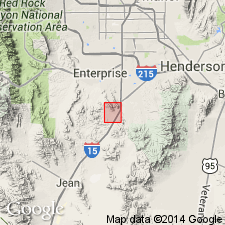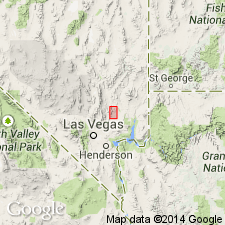
- Usage in publication:
-
- Monte Cristo limestone*
- Modifications:
-
- Named
- Dominant lithology:
-
- Limestone
- Dolomite
- AAPG geologic province:
-
- Great Basin province
Summary:
Divided on the basis of bedding features and chert and fossil content (corals, bryozoans, brachiopods, mollusks, echinoderms, crustaceans) into (ascending): Dawn limestone (60 to 400 ft thick), Anchor limestone (65 to 400 ft), Bullion dolomite (185 to 300 ft), Arrowhead limestone (0 to 20 ft), and Yellowpine limestone (0 to 120 ft) members. Unconformably underlies Bird Spring formation (new) (Pennsylvanian age) and tuff and breccia of Tertiary age. Overlies Sultan limestone (new). G.H. Girty identified fossils of Early and middle[!] Mississippian age. [Mr. Hewett sent advance copy of Goodspring section with proposed names to W.S. Glock who in 1929 (Amer. J. Sci. 5th ser, v.17 p.326-339) described Monte Cristo limestone in Spring Mountain Range, Goodsprings quad]. Assigned Mississippian age on geologic map of Goodsprings quad.
Source: GNU records (USGS DDS-6; Menlo GNULEX).

- Usage in publication:
-
- Monte Cristo limestone*
- Modifications:
-
- Areal extent
- Biostratigraphic dating
- AAPG geologic province:
-
- Great Basin province
Summary:
Monte Cristo(?) limestone in northern summits of Nopah Range is tentatively correlated with Monte Cristo limestone in Goodsprings, NV area. Composite section [T51S, R8E; location map in Jenkins, 1937 (same volume)] divided into upper and lower members is 987+ feet thick. Lower member may be equal approximately to Dawn and Anchor limestone [members] and upper member to Bullion dolomite [member]. Fossils (similar to those collected from Dawn and Anchor limestone members) were examined by J.F. Mason. Unconformably overlies Stewart Valley limestone. Underlies Bird Spring(?) formation. Assigned Mississippian age on basis of fossils.
Source: GNU records (USGS DDS-6; Menlo GNULEX).

- Usage in publication:
-
- Monte Cristo dolomite*
- Modifications:
-
- Areal extent
- Redescribed
- AAPG geologic province:
-
- Great Basin province
Summary:
Renamed Monte Cristo dolomite in Sloan district, NV, where map shows Dawn, Anchor, and Bullion members. Total thickness of composite stratigraphic section (E/2 SW/4 sec.12, N/2 SW/4 NE/4 and S/2 NW/4 NE/4 sec.13, T23S, R60E) on Sloan hill is 695 ft. Overlies Crystal Pass limestone member of Sultan limestone; underlies Bird Spring formation. Is Mississippian age.
Source: GNU records (USGS DDS-6; Menlo GNULEX).

- Usage in publication:
-
- Monte Cristo limestone*
- Modifications:
-
- Mapped
- AAPG geologic province:
-
- Great Basin province
Summary:
Monte Cristo limestone and included members (ascending): Dawn limestone, Anchor limestone (divided into lower and upper beds), Bullion dolomite, Arrowhead limestone, and Yellowpine limestone members are structurally and lithologically described with maps and cross sections near each of mines in Yellow Pine district, NV. Maps indicate Mississippian age.
Source: GNU records (USGS DDS-6; Menlo GNULEX).

- Usage in publication:
-
- Monte Cristo limestone*
- Modifications:
-
- Revised
- AAPG geologic province:
-
- Great Basin province
Summary:
In Nopah Range Monte Cristo limestone is composed of (ascending): Dawn limestone, Anchor limestone, Bullion limestone, and Yellowpine limestone members. Arrowhead limestone is not recognized. Thickness is 1587 ft. Name Stewart Valley limestone is abandoned and Mississippian beds previously assigned to it are assigned to Dawn limestone member. Overlies Crystal Pass member of Sultan limestone; underlies Bird Spring formation. Stratigraphic section shows unit is Mississippian (Osagean) age.
Source: GNU records (USGS DDS-6; Menlo GNULEX).

- Usage in publication:
-
- Monte Cristo limestone*
- Modifications:
-
- Areal extent
- AAPG geologic province:
-
- Great Basin province
Summary:
Name is derived from Monte Cristo mine, Goodsprings [special] quad, Clark Co, NV. Monte Cristo limestone and its five included members are recognized throughout north half of Ivanpah (1 deg) quad, CA and NV and also in Old Dad Mountain, San Bernardino Co, CA in southwest corner of quad. Total thickness is 400 to 800 ft. Age is considered to be Early Mississippian based on fossils (corals, echinoderms, bryozoans, brachiopods, mollusks, trilobites, ostracodes) identified by G.H. Girty in 1928.
Source: GNU records (USGS DDS-6; Menlo GNULEX).

- Usage in publication:
-
- Monte Cristo limestone*
- Modifications:
-
- Areal extent
- AAPG geologic province:
-
- Great Basin province
Summary:
Monte Cristo limestone described as limestone in south part of Clark Co, NV, and as sandstone and shale increasingly to northwest. Geographically extended from Spring Mountains to Las Vegas Bombing and Gunnery Range, Arrow Canyon Range and Meadow Valley Mountains. Age shown as Early and Late Mississippian.
Source: GNU records (USGS DDS-6; Menlo GNULEX).

- Usage in publication:
-
- Monte Cristo Group
- Modifications:
-
- Revised
- AAPG geologic province:
-
- Great Basin province
Summary:
Monte Cristo Limestone of Hewett(1931) raised in rank to Monte Cristo Group. Members are raised to formation rank. In Arrow Canyon Range units included are (ascending): Dawn Limestone (up to 200 ft thick), Anchor Limestone (up to 800 ft thick), Bullion Limestone (up to 510 ft), and Yellowpine Limestone (up to 100 ft). Arrowhead Limestone is absent in Arrow Canyon Range. These units also occur at Bitter Spring Gap in Muddy Mountains (Langenheim, 1956). Composite columnar section shows group unconformably underlies Bird Spring Group and unconformably overlies Crystal Pass Limestone. Age is Mississippian.
Source: GNU records (USGS DDS-6; Menlo GNULEX).

- Usage in publication:
-
- Monte Cristo Limestone*
- Modifications:
-
- Areal extent
- AAPG geologic province:
-
- Great Basin province
Summary:
At Indian Springs, northwest Clark County, NV, thick-bedded gray limestone of Monte Cristo Limestone is disconformably overlain by Chainman Shale equivalent of Late Mississippian age based on faunal evidence. Monte Cristo Limestone is considered to be Early and Late Mississippian age.
Source: GNU records (USGS DDS-6; Menlo GNULEX).

- Usage in publication:
-
- Monte Cristo Limestone*
- Modifications:
-
- Areal extent
- AAPG geologic province:
-
- Great Basin province
Summary:
Is exposed in east Mormon Mountains (sec.31? T11S R69E) in southeast Lincoln Co, NV, where all five members of Hewett (1931) are described by Langenheim (1956). These members except for Arrowhead Limestone Member are also recognizable in Arrow Canyon Range, Clark Co, NV. In east part of Clark Co, Monte Cristo Limestone grades into dolomite and limestone facies. Here Rogers Spring Limestone (Longwell and others, 1965) contains three persistent members equivalent to Dawn Limestone, Anchor Limestone, and Bullion Dolomite Members of Monte Cristo Limestone. Map indicates Mississippian age.
Source: GNU records (USGS DDS-6; Menlo GNULEX).

- Usage in publication:
-
- Monte Cristo Limestone*
- Modifications:
-
- Areal extent
- AAPG geologic province:
-
- Great Basin province
Summary:
Monte Cristo Limestone has been mapped and described in north Spring Mountains at east edge of south Nye Co, NV (Vincelette, 1964). Geologic map (in this paper) of south Nye Co also shows 2 outcrops northwest of Pahrump Valley. Unconformably overlies Devils Gate Limestone and Nevada Formation (undivided) and also Bonanza King Formation. Unconformably underlies Quaternary alluvium. Hewett (1931) is credited with saying Anchor Limestone and Bullion Dolomite Members are of Early Mississippian age and that Arrowhead and Yellowstone Limestone Members are of Late[!] Mississippian age.
Source: GNU records (USGS DDS-6; Menlo GNULEX).

- Usage in publication:
-
- Monte Cristo Group
- Modifications:
-
- Areal extent
- Biostratigraphic dating
- AAPG geologic province:
-
- Great Basin province
Summary:
Four members of Monte Cristo Group (Dawn Limestone, Anchor Limestone, Bullion Formation, Yellowpine Limestone) are recognized at Tungsten Gap, Arrow Canyon Range, Clark Co, NV. Nine conodont zones are recognized. Age is Mississippian (late Kinderhookian through early Meramecian; Tournaisian and early Visean).
Source: GNU records (USGS DDS-6; Menlo GNULEX).

- Usage in publication:
-
- Monte Cristo Limestone
- Modifications:
-
- Areal extent
- AAPG geologic province:
-
- Great Basin province
Summary:
Unit is extended into New York Mountains, CA. Monte Cristo Limestone in coarse-grained marble. Three members can be recognized. Dawn Member is dark gray recrystallized marble; Anchor Member is dark gray marble with chert nodules; Bullion Member is coarse-grained white calcite and dolomite marble containing rare chert nodules. Age is Mississippian.
Source: GNU records (USGS DDS-6; Menlo GNULEX).

- Usage in publication:
-
- Monte Cristo Limestone*
- Modifications:
-
- Areal extent
- AAPG geologic province:
-
- Great Basin province
Summary:
Geographically extended into Wah Wah Mountains, Beaver County, Utah; unit is not subdivided into members. Is essentially same unit as Blonde Mountain Formation of Miller (1959). Is 150 to 280 m thick. Consists of medium- to thick-bedded, medium- to bluish-gray, medium- to fine-grained fossiliferous limestone where unaltered. Includes abundant medium- to coarse-grained, dusky-gray dolomite. Fossils include gastropods, brachiopods, solitary and colonial corals, typical of Early Mississippian Madison fauna of western U.S. Age is Mississippian.
Source: GNU records (USGS DDS-6; Menlo GNULEX).

- Usage in publication:
-
- Monte Cristo Limestone*
- Modifications:
-
- Mapped
- AAPG geologic province:
-
- Great Basin province
Summary:
Mapped in Nopah Range Wilderness Study Area where unit is described as light-gray to medium-gray dolomitic to crinoidal limestone, lime mudstone to oolitic grainstone. Overlies Los Burro Formation of Devonian age. Unconformably underlies Quaternary alluvium. Assigned Mississippian age.
Source: GNU records (USGS DDS-6; Menlo GNULEX).

- Usage in publication:
-
- Monte Cristo Formation*
- Modifications:
-
- Areal extent
- AAPG geologic province:
-
- Great Basin province
Summary:
Unit mapped as Bird Spring and Monte Cristo Formations, undivided. Unit geographically extended into report area (southern Avawatz Mountains, northeastern Mojave Desert, CA). Age given as Mississippian.
Source: GNU records (USGS DDS-6; Menlo GNULEX).

- Usage in publication:
-
- Monte Cristo Limestone*
- Modifications:
-
- Areal extent
- AAPG geologic province:
-
- Plateau sedimentary province
Summary:
Extended into northwest Mohave Co, AZ, Plateau sedimentary province. [Extended from Muddy and northern Black Mountains, Clark Co, NV]. Consists of five members which are, in ascending order, Dawn, Anchor, Bullion, Arrowhead and Yellowpine Members. Unit is equivalent in part to Redwall Limestone of Colorado Plateaus Province [physiographic province]. Unconformably overlies unnamed limestone unit of Devonian and Mississippian age (probably equivalent to Valentine and part of Crystal Pass Members of Sultan Limestone or parts of Rogers Spring Limestone and is equivalent in part to Temple Butte Limestone). Unconformably underlies Bird Spring Formation. Thickness is 225-350 m. Early and Late Mississippian age.
Source: GNU records (USGS DDS-6; Denver GNULEX).

- Usage in publication:
-
- Monte Cristo Limestone*
- Modifications:
-
- Areal extent
- AAPG geologic province:
-
- Great Basin province
Summary:
Unit is geographically extended into report area (southern Sheep Range, Fossil Ridge, and Castle Rock area, Clark Co, NV) as the Monte Cristo Limestone. Age given as Early Mississippian.
Source: GNU records (USGS DDS-6; Menlo GNULEX).

- Usage in publication:
-
- Monte Cristo Limestone*
- Modifications:
-
- Areal extent
- Overview
- AAPG geologic province:
-
- Great Basin province
Summary:
Extended into Washington Co, UT, and Lincoln Co, NV, Great Basin province. Exposures mapped in central part of quad and along edge of northwest part of quad. Consists of massive light gray limestone; some beds are bioclastic with small crinoidal fragments; some beds contain large chert nodules. Weathers to ragged massive ledges. Anchor Member is recognizable on southwest flank of Hill 4069, though is not separately mapped. Thickness is about 300 m. Conformably overlies Muddy Peak Dolomite; conformably underlies Bird Spring Formation. Mississippian age.
Source: GNU records (USGS DDS-6; Denver GNULEX).
For more information, please contact Nancy Stamm, Geologic Names Committee Secretary.
Asterisk (*) indicates published by U.S. Geological Survey authors.
"No current usage" (†) implies that a name has been abandoned or has fallen into disuse. Former usage and, if known, replacement name given in parentheses ( ).
Slash (/) indicates name conflicts with nomenclatural guidelines (CSN, 1933; ACSN, 1961, 1970; NACSN, 1983, 2005, 2021). May be explained within brackets ([ ]).

